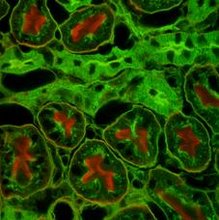pp 22 and 209 , R Ian Freshney
Material requirements:
Sterile:
A549 cells, 7 days and 14 days after seeding at 2X 104 cells/ml 25 cm2 flaks
WI-38, MRC-5 or an equivalent normal diploid fibroblast culture, 7 days and 14 days after seeding at 2X 104 cells/ml 25 cm2 flaks
Growing medium, e.g. 1X MEM with Earle’s salts, 23mM HCO3 without antibiotics 100 ml
Trypsin 0.25 % in D-PBSA 10 ml
Pipettes (graduated and plugged) glass – of 1//5/10/25 ml
Unplugged pipettes with the vacuum line
Culture flasks 25 cm2
Non-sterile:
Bulb, Tubing receiver to vacuum line or plastic pump
Alcohol 70 %
Lint free swabs or wipes
Absorbent tissue papers
Marker pen with alcohol insol. Inc
Hemocytometer/Electronic cell counter
Protocol:
Prepare the hood and bring reagents and materials to the hood to begin procedure
Examine cultures carefully for signs of deterioration or contamination
Check criteria and based on knowledge for behavior of culture and decide whether or not to subculture
Take culture flask to sterile working area and remove and discard medium. Handle each cell line separately, repeating procedure from this step for each cell line handled
Add D-PBSA/EDTA prewash (0.2ml/cm2) to the side of flask opposite the cells. Turn the flaks over and lay them down, ensure that the monolayer is completely covered. Leave the flasks stationary for 15-30 sec.
Raise the flasks to remove the trypsin from the monolayer and quickly check the monolayer is not detaching. Using tryspin at 40C helps to prevent premature detachment, if this turn out to be problem.
Withdraw all but few drops of trypsin
Incubate with the flask lying flat until the cells round up. When the bottle is tilted, the monolayer should slide down the surface (this usually occurs after 5-15 min). Do not leave the flask longer than necessary, but on the other hand, do not force the cells to detach before they are ready to do so or else clumping may result
Add medium (0.1-0.2 ml/cm2) m and disperse the cells by repeated pipetting over the surface bearing the monolayer
Finally, pipette cells up and down a few times, with the tip of the pipette resting on the bottom corner of bottle, taking care not to create a foam. The degree of pipetting required will vary from one cell line to another, some cell lines disperse easily, wheras others require vigorous pipetting in order to disperse them. Almost all cells incur mechanical damage from shearing forces if pippeted too vigorously. Primary suspensions and early passage cultures are particularly prone to damage, partly because of their greater fragility and partly because of their size. But continuous cell lines are usually more resilient and require vigorous pipetting for complete disaggregation. Pipette the suspension up and down sufficiently to disperse the cells into single cell suspension. If this step is difficult, apply a more aggressive dissociating agent.
a single cell suspension is desirable at subculture to ensure an accurate cell count and uniform growth on reseeding . Its is essential if qualitative estimates of cell proliferation or of plating efficiency are being made and if cells are to be isolated as clones.
Count the cells with hemocytometer or an electronic particle counter and record the cell counts.
Dilute cell suspensions to appropriate seeding conc.,
By adding appropriate volume of cell suspension to a pre-measured volume of medium in a culture flask OR
By diluting cells the total volume required and distributing that volume among several flasks
a procedure is useful for routine subculture when only few flasks are used and precise cell counts and reproducibility are not critical, but procedure b. is preferred when setting up several replicates because of total number of manipulations is reduced and the conc. Of cells in each flask is identical.
Use procedure B and dilute cell from each flasks to 2 X 104 cells/ml in 20ml medium and seed 5ml from each suspension into two flask
If cells are grown in elevated CO2 gas the flasks by blowing the correct gas mixture (5% CO2) from premixed cylinder or a gas blender through a filtered line into the flask above the medium. Do not bubble gas through medium, as doing so will generate bubbles, which can denature some constituents of the medium and increase the risk of contamination. If normal gas phase is air as with Eagle’s MEM with Hank’s salts this step may be omitted
Cap the flask and return to the incubator. Check pH after about 1 hr. if Ph rises I n medium with gas phase of airthen return the flask to aseptic area and gas culture briefly (1-2s) with 5% CO2. as each culture will behave predictably in the same medium , you eventually will know which cells to gas when they are reseeded, without having to incubate them first. If the pH rises in medium that already has 5% CO2 gas phase either increase CO2 to 7 % or 10 % or add sterile 0.1 N HCL.
Repeat same procedure from step 4 for second cell line.
Subscribe to:
Post Comments (Atom)


No comments:
Post a Comment